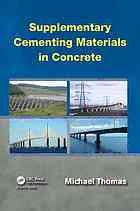
Supplementary cementing materials in concrete PDF
Preview Supplementary cementing materials in concrete
Supplementary Cementing Materials in Concrete Michael Thomas A SPON BOOK Supplementary Cementing Materials in Concrete Supplementary Cementing Materials in Concrete Michael Thomas Boca Raton London New York CRC Press is an imprint of the Taylor & Francis Group, an informa business CRC Press Taylor & Francis Group 6000 Broken Sound Parkway NW, Suite 300 Boca Raton, FL 33487-2742 © 2013 by Taylor & Francis Group, LLC CRC Press is an imprint of Taylor & Francis Group, an Informa business No claim to original U.S. Government works Version Date: 20121128 International Standard Book Number-13: 978-1-4665-7301-7 (eBook - PDF) This book contains information obtained from authentic and highly regarded sources. Reasonable efforts have been made to publish reliable data and information, but the author and publisher cannot assume responsibility for the validity of all materials or the consequences of their use. The authors and publishers have attempted to trace the copyright holders of all material reproduced in this publication and apologize to copyright holders if permission to publish in this form has not been obtained. If any copyright material has not been acknowledged please write and let us know so we may rectify in any future reprint. Except as permitted under U.S. Copyright Law, no part of this book may be reprinted, reproduced, transmit- ted, or utilized in any form by any electronic, mechanical, or other means, now known or hereafter invented, including photocopying, microfilming, and recording, or in any information storage or retrieval system, without written permission from the publishers. For permission to photocopy or use material electronically from this work, please access www.copyright. com (http://www.copyright.com/) or contact the Copyright Clearance Center, Inc. (CCC), 222 Rosewood Drive, Danvers, MA 01923, 978-750-8400. CCC is a not-for-profit organization that provides licenses and registration for a variety of users. For organizations that have been granted a photocopy license by the CCC, a separate system of payment has been arranged. Trademark Notice: Product or corporate names may be trademarks or registered trademarks, and are used only for identification and explanation without intent to infringe. Visit the Taylor & Francis Web site at http://www.taylorandfrancis.com and the CRC Press Web site at http://www.crcpress.com Contents Preface ix About the Author xi 1 Introduction 1 1.1 What Are SCMs? 1 1.2 History of Use 2 2 Origin and nature of SCMs 5 2.1 General 5 2.2 Fly Ash 8 2.2.1 Production of fly ash 8 2.2.2 Composition and properties of fly ash 9 2.2.3 Fly ash beneficiation 15 2.2.4 Fly ash classification 16 2.3 Slag 18 2.3.1 Production of slag 18 2.3.2 Composition and properties of slag 19 2.3.3 Classification of slag 21 2.4 Silica Fume 22 2.4.1 Production of silica fume 22 2.4.2 Composition and properties of silica fume 22 2.4.3 Silica fume product forms 25 2.5 Natural Pozzolans 26 2.5.1 Types of natural pozzolans 26 2.5.2 Glassy volcanic pozzolans 27 2.5.3 Volcanic tuff 28 2.5.4 Calcined clay and shales 28 v vi Contents 2.5.5 Diatomaceous earth and opaline silica 29 2.5.6 Rice husk ash 29 3 Chemical reactions of SCMs in concrete 31 3.1 Pozzolanic Reactions 31 3.2 Hydration of Slag 36 3.3 Effect of SCMs on the Hydration of Portland Cement 37 3.4 Effect of SCMs on the Pore Solution Composition 39 4 Microstructure of portland cement—SCM systems 45 4.1 Pore Structure 45 4.2 Interfacial Transition Zone (ITZ) 53 4.3 Pore Blocking and Mass Transport 54 5 Properties of fresh concrete 57 5.1 Workability and Water Demand 57 5.2 Bleeding 62 5.3 Air Entrainment 63 5.4 Setting Time 65 6 Temperature rise and risk of thermal cracking 69 6.1 Temperature Rise 69 6.2 Risk of Thermal Cracking 75 7 Mechanical properties 77 7.1 Compressive Strength 77 7.1.1 Effect of temperature 81 7.1.2 Temperature-matched curing 83 7.1.3 Cementing efficiency (or k value) concept 84 7.2 Flexural and Tensile Strength 86 7.3 Modulus of Elasticity 87 8 Volume stability 91 8.1 Chemical and Autogenous Shrinkage 91 8.2 Drying Shrinkage 93 8.3 Creep 95 8.4 Temperature Changes 100 Contents vii 9 Durability of concrete 103 9.1 Permeability 104 9.2 Corrosion of Steel Reinforcement, Chloride Ingress, and Carbonation 105 9.2.1 Corrosion of steel reinforcement 105 9.2.2 Chloride ingress 109 9.2.3 Rapid chloride permeability test (RCPT) 115 9.2.4 Carbonation 118 9.3 Resistance to Freezing and Thawing, and De-Icer Salt Scaling 126 9.4 Alkali-Silica Reaction (ASR) 136 9.5 Sulfate Attack 145 9.6 Heat-Induced Delayed Ettringite Formation 153 9.7 Physical Salt Attack 156 9.8 Other Forms of Chemical Attack 158 9.9 Abrasion, Erosion, and Cavitation 159 10 Specifications 161 10.1 ASTM Specifications for SCMs 161 10.2 ASTM Specifications for Blended Cements— ASTM C 595 163 10.3 ASTM Performance Specification for Hydraulic Cements—ASTM C 1157 164 References 167
